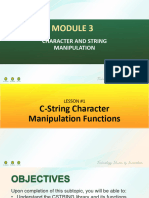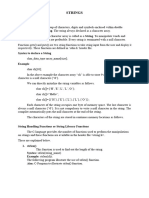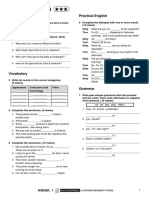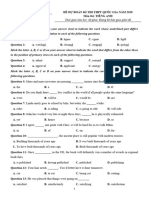Java WrapperClasses 2
Uploaded by
Anand DhanalakotaJava WrapperClasses 2
Uploaded by
Anand DhanalakotaJAVA - CHARACTER CLASS
http://www.tuto rialspo int.co m/java/java_characte rs.htm
Co pyrig ht tuto rials po int.co m
Normally, when we work with characters, we use primitive data types char.
Example:
char ch = 'a'; // Unicode for uppercase Greek omega character char uniChar = '\u039A'; // an array of chars char[] charArray ={ 'a', 'b', 'c', 'd', 'e' };
However in development, we come across situations where we need to use objects instead of primitive data types. In order to achieve this, Java provides wrapper class Charac ter for primitive data type char. T he Character class offers a number of useful class (i.e., static) methods for manipulating characters. You can create a Character object with the Character constructor:
Character ch = new Character('a');
T he Java compiler will also create a Character object for you under some circumstances. For example, if you pass a primitive char into a method that expects an object, the compiler automatically converts the char to a Character for you. T his feature is called autoboxing or unboxing , if the conversion g oes the other way.
Example:
// Here following primitive char 'a' // is boxed into the Character object ch Character ch = 'a'; // Here primitive 'x' is boxed for method test, // return is unboxed to char 'c' char c = test('x');
Escape Sequences:
A character preceded by a backslash (\) is an escape sequence and has special meaning to the compiler. T he newline character (\n) has been used frequently in this tutorial in System.out.println() statements to advance to the next line after the string is printed. Following table shows the Java escape sequences:
Esc ape Sequenc e \t \b \n \r \f \' \"
Desc ription Inserts a tab in the text at this point. Inserts a backspace in the text at this point. Inserts a newline in the text at this point. Inserts a carriag e return in the text at this point. Inserts a form feed in the text at this point. Inserts a sing le quote character in the text at this point. Inserts a double quote character in the text at this point.
\\
Inserts a backslash character in the text at this point.
When an escape sequence is encountered in a print statement, the compiler interprets it according ly.
Example:
If you want to put quotes within quotes you must use the escape sequence, \", on the interior quotes:
public class Test { public static void main(String args[]) { System.out.println("She said \"Hello!\" to me."); } }
T his would produce the following result:
She said "Hello!" to me.
Character Methods:
Here is the list of the important instance methods that all the subclasses of the Character class implement:
SN 1 2 3 4 5 6 7 8
Methods with Desc ription isLetter() Determines whether the specified char value is a letter. isDig it() Determines whether the specified char value is a dig it. isWhitespace() Determines whether the specified char value is white space. isUpperCase() Determines whether the specified char value is uppercase. isLowerCase() Determines whether the specified char value is lowercase. toUpperCase() Returns the uppercase form of the specified char value. toLowerCase() Returns the lowercase form of the specified char value. toString () Returns a String object representing the specified character valuethat is, a one-character string .
For a complete list of methods, please refer to the java.lang .Character API specification.
What is Next?
In the next section, we will be g oing throug h the String class in Java. You will be learning how to declare and use String s efficiently as well as some of the important methods in the String class.
You might also like
- Example:: // Unicode For Uppercase Greek Omega CharacterNo ratings yetExample:: // Unicode For Uppercase Greek Omega Character2 pages
- Chapter 9: String, Stringbuffer, Stringbuilder (3 HRS) Chapter ObjectivesNo ratings yetChapter 9: String, Stringbuffer, Stringbuilder (3 HRS) Chapter Objectives8 pages
- Java Programming: Arrays & String ManipulationNo ratings yetJava Programming: Arrays & String Manipulation23 pages
- Java Strings: Creating Strings String MethodsNo ratings yetJava Strings: Creating Strings String Methods19 pages
- Lecture 01 - Mathematical Functions, Characters, And StringsNo ratings yetLecture 01 - Mathematical Functions, Characters, And Strings36 pages
- Strings_b4715a8d691742b70a4dca84136be5daNo ratings yetStrings_b4715a8d691742b70a4dca84136be5da20 pages
- UNIT - V - STRING HANDLING IN JAVA UPDATEDNo ratings yetUNIT - V - STRING HANDLING IN JAVA UPDATED39 pages
- Class String: Java - Lang.object Java - Lang.stringNo ratings yetClass String: Java - Lang.object Java - Lang.string6 pages
- APznzabNHgCmiW SVj2ucK2AXy q 2zYqzo9HEimlI9oJQrvBkcTh8Yb8wrHw9KfqvIvqjdwl1s9uAs7qYIMCnlqVUv47q0UtsTyeztNkLMIpzr3g11hecqXD219o8JrIVlNgvh5GBH5Ccm1Orns49G50f4arC COPu7tKrN6q29IEUfVCIejNo ratings yetAPznzabNHgCmiW SVj2ucK2AXy q 2zYqzo9HEimlI9oJQrvBkcTh8Yb8wrHw9KfqvIvqjdwl1s9uAs7qYIMCnlqVUv47q0UtsTyeztNkLMIpzr3g11hecqXD219o8JrIVlNgvh5GBH5Ccm1Orns49G50f4arC COPu7tKrN6q29IEUfVCIej16 pages
- C++ Header Files and Standard Functions: Assert. You Use Assertwrites An Error Assert #Define NDEBUGNo ratings yetC++ Header Files and Standard Functions: Assert. You Use Assertwrites An Error Assert #Define NDEBUG5 pages
- Senior UFT Automation Test Engineer - Hyderabad-Immediate Joiner OnlyNo ratings yetSenior UFT Automation Test Engineer - Hyderabad-Immediate Joiner Only3 pages
- Java Program To Display Prime Numbers Between Intervals Using FunctionNo ratings yetJava Program To Display Prime Numbers Between Intervals Using Function2 pages
- Senior Test Engineer - Hyderabad - Secunderabad - Aveva - 7 To 10 Years of ExperienceNo ratings yetSenior Test Engineer - Hyderabad - Secunderabad - Aveva - 7 To 10 Years of Experience3 pages
- Immediate Hiring Test Analyst (Selenium With UFT) - Hyderabad - Secunderabad - Euclid Innovations Private Limited - 5 To 10 Years of ExperienceNo ratings yetImmediate Hiring Test Analyst (Selenium With UFT) - Hyderabad - Secunderabad - Euclid Innovations Private Limited - 5 To 10 Years of Experience3 pages
- Automation UFT Specialist - Hyderabad - Secunderabad - Luxoft - 4 To 8 Years of ExperienceNo ratings yetAutomation UFT Specialist - Hyderabad - Secunderabad - Luxoft - 4 To 8 Years of Experience3 pages
- Automation Architect - Hyderabad - Secunderabad - Isearch Consulting Services PVT LTD - 10 To 15 Years of ExperienceNo ratings yetAutomation Architect - Hyderabad - Secunderabad - Isearch Consulting Services PVT LTD - 10 To 15 Years of Experience3 pages
- Java Program To Generate Multiplication TableNo ratings yetJava Program To Generate Multiplication Table2 pages
- Java Program To Find The Largest Among Three Numbers (If-Else & Nested If-Else)No ratings yetJava Program To Find The Largest Among Three Numbers (If-Else & Nested If-Else)3 pages
- Java Program To Find ASCII Value of A CharacterNo ratings yetJava Program To Find ASCII Value of A Character1 page
- Java Program To Display Fibonacci SeriesNo ratings yetJava Program To Display Fibonacci Series3 pages
- Java Program To Check Whether A Number Is Even or Odd (If-Else & Ternary)No ratings yetJava Program To Check Whether A Number Is Even or Odd (If-Else & Ternary)2 pages
- Uft - QTP - HTML Dom - Automation TutorialNo ratings yetUft - QTP - HTML Dom - Automation Tutorial8 pages
- Java Program To Check Whether A Number Is Positive or NegativeNo ratings yetJava Program To Check Whether A Number Is Positive or Negative2 pages
- Java Program To Find All Roots of A Quadratic EquationNo ratings yetJava Program To Find All Roots of A Quadratic Equation2 pages
- Java Program To Check Whether An Alphabet Is Vowel or Consonant (If-Else & Switch-Case)No ratings yetJava Program To Check Whether An Alphabet Is Vowel or Consonant (If-Else & Switch-Case)2 pages
- Java Program To Calculate The Sum of Natural NumbersNo ratings yetJava Program To Calculate The Sum of Natural Numbers2 pages
- Deutsch Aber Hallo A1 Bearb ENGLISH TranslateNo ratings yetDeutsch Aber Hallo A1 Bearb ENGLISH Translate32 pages
- De Thi Thu TN 2023 Tieng Anh Ly Thai To Bac Ninh Lan 1No ratings yetDe Thi Thu TN 2023 Tieng Anh Ly Thai To Bac Ninh Lan 14 pages
- 2) Real Phrasal Verbs - Exercises - EasyNo ratings yet2) Real Phrasal Verbs - Exercises - Easy1 page
- ENGLISH Question Paper Kerala Plus Two Second Term Half Yearly Christmas Exam Dec 2019No ratings yetENGLISH Question Paper Kerala Plus Two Second Term Half Yearly Christmas Exam Dec 20194 pages
- IMO 2014 Problmes With Selected SolutionsNo ratings yetIMO 2014 Problmes With Selected Solutions8 pages
- Linguistic Transition at Tertiary Level A Case StudyNo ratings yetLinguistic Transition at Tertiary Level A Case Study7 pages
- English For Academic Purposes: January 2017No ratings yetEnglish For Academic Purposes: January 201733 pages
- Wrangling Women Humor and Gender in the American West Kristin M. Mcandrews - The ebook in PDF format with all chapters is ready for downloadNo ratings yetWrangling Women Humor and Gender in the American West Kristin M. Mcandrews - The ebook in PDF format with all chapters is ready for download47 pages
- Organ of Speech Airstream Mechanism (Kel 1)No ratings yetOrgan of Speech Airstream Mechanism (Kel 1)7 pages
- Question Paper Prose Composition or ComprehensionNo ratings yetQuestion Paper Prose Composition or Comprehension4 pages
- Simple Compound Complex and Compound Complex SentencesNo ratings yetSimple Compound Complex and Compound Complex Sentences7 pages
- - Đề chuẩn Tiếng Anh 2020 - Đề 1 (Mini test)No ratings yet- Đề chuẩn Tiếng Anh 2020 - Đề 1 (Mini test)18 pages













































































































